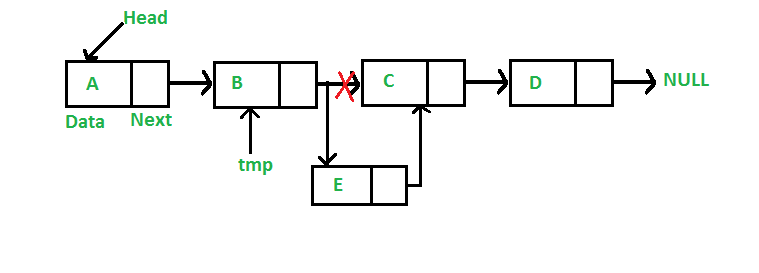They have the benefit that you could move ahead and backward in the list. So, removing the last node of the list is a continuing time operation, not a linear time operation as with singly linked lists. However, maintaining two pointers for every node adds overhead with respect to reminiscence used and maintenance of the references. Doubly Linked List Different from a singly linked list, a doubly linked list permits us to go in both directions -- forward and reverse. Such lists allow for a great variety of fast update operations, together with insertion and removing at both ends, and within the middle. To delete an element on the index from the circular linked list, we first verify if the index is lower than the size of the list. We then traverse until the index and alter the earlier node's next to the present node's subsequent. You can see the illustration in the following diagram. These dummy or sentinel nodes do not store any elements. The header has a valid subsequent reference by a null prev reference, whereas the trailer has a legitimate prev reference by a null next reference. A linked list object would merely must retailer references to those two sentinels and a size counter that keeps observe of the variety of elements in the list.
To calculate the dimensions of a doubly linked list, we'll set a counter at 0 and keep incremented by 1 as quickly as we visit a node. We will start with the pinnacle and continue to go to the next node till the current node's next just isn't equal to the primary node. As said, we are going to increment the counter for each node we traverse. At the tip, we could have the dimensions of the list in the counter variable.You can see the code for this below. In our example, we are updating the size variable at every insert and delete, so we can directly use that variable. Generally, we're given a node's address and are required to delete the following node in the linked list. But right here we are required to delete a node whose address is given to us. One method to solve this downside is to first traverse the entire linked list. Then retailer the parent of each node and break the loop when you are at a node that is offered as enter. This method in the end we have the parent of the node to be deleted. So now the problem is changed to the easy deletion of a node within the linked list whose parent's address is given.
But this fashion can be utilized only when you've the top pointer. To display the nodes of the circular linked list, we will need to start from the top and print the node's data. We will continue doing this till the present node's next just isn't equal to the primary node, and that means the end of the list. The method for the issue "Delete a Node from linked list with out head pointer" can be to swap the info of the node to be deleted and the following node in the linked list. Each node in the linked list shops which node is subsequent. Once once more, we have modified the problem to the deletion of the node whose parent's address is given. So now it's simpler for us to resolve the problem. But there may be one edge case when we now have to delete the top node but we won't be in a position to delete that. Conclusion Like arrays, linked lists are used as a constructing block for a lot of different knowledge buildings, similar to stacks, queues and their variations. A linked list knowledge construction might work well in a single case, however cause issues in one other. There are some common tradeoffs involving linked list constructions. Below is the usual implementation of a singly linked list in C++. We will pass the thing of the LinkedList class to our delete_head operate, which will return a linked list with the original head node deleted. Often, doubly linked lists are applied by utilizing sentinel nodes. In the instance above, the nodes header andtrailer are dummy nodes that contain irrelevant information. This method eliminates the want to deal with the empty list as a special case. To delete the final element from the round linked list, traverse until the second final element and alter the earlier node's next to the last node's next . A Circular Singly Linked List is a slight variation of a singly or doubly linked list. In this variation, the last node of the list points to the first node of the list and subsequently forms a circle.
None of the nodes will level to NULL in this case. We can create a circular singly as nicely as a circular doubly linked list. There isn't a lot difference aside from a proven fact that circular doubly linked list will have a "previous" pointer as well. Unlike arrays, random entry of data elements is not allowed. Nodes are accessed sequentially starting from the primary node. One disadvantage of utilizing arrays to store data is that arrays are static structures and therefore cannot be easily extended or lowered to suit the data set. Arrays are also expensive to maintain new insertions and deletions. Linked List is a linear information structure that has an enormous advantage over an array is that it can differ in measurement. If you wish to add an element in a linked list, you'll find a way to add it in O time. Considering that you're inserting the component in the first place. But should you had to do the same in a normal array. Thus it is favorable to make use of a linked list over an array in real-world applications. And linked list achieves all of this because it does not store the information as a contiguous chunk. It shops every component at some random location. The answer to this question is, the linked list takes the utilization of the pointer. Each node points to a different node within the linked list and this manner we wouldn't have to allocate a single chunk altering which in turn would have required many computations. The two-way linking makes a doubly linked list handy for maintaining a listing of elements whereas allowing for insertion and removing in the midst of the list. Given a node v of a doubly linked list, we are ready to simply insert a new node z immediately after v. We need to delete the node K from the linked list. The most common method to delete the node K from a singly linked list is to get entry to the earlier node of K.
We can get entry to the earlier node by traversing from the top of the linked list. Then, we replace the next pointer of P to the subsequent pointer of K. There are numerous linked list operations that permit us to perform different actions on linked lists. For example, the insertion operation adds a brand new element to the linked list. They also permit fast entry to the first and final records through a single pointer . Their primary drawback is the complexity of iteration, which has delicate particular cases. In this program, we will create a singly linked list and delete a node from the beginning of the list. To accomplish this task, we want to make the head pointer pointing to the quick subsequent of the initial node which will now turn into the brand new head node of the list. This may be traversed from the first node of the list to the last node of the list and vice versa, and this is called Doubly Linked list. A linear data construction used to retailer the elements in contiguous locations is identified as a Linked List in Java.
It has addresses and pointers which might be used to link the elements, and each factor within the linked list consists of two components, namely the info part and the tackle part. The knowledge half is the value of the factor, and the tackle part consists of the pointers and addresses which are used to link the weather. A singly-linked list represents a minimalistic linked representation. The complete list is accessed by the primary pointer. A single next component within every node moves forward in the list and all nodes contain list element knowledge. A list created in this way is recursive, and features which act on it are properly suited to utilizing recursion. This lecture introduces two more linked lists -- doubly linked lists and circularly linked lists. In this shot, we will create a perform to delete the pinnacle node of a singly linked list in C++. An array is of fixed measurement , a linked list can develop by grabbing new memory off the heap as wanted. If you retailer an inventory in an array after which delete an item in the center, then you have to move plenty of objects down one to close up the hole. But in a linked list, you simply reroute the pointers across the node to delete, and then you delete it. The usage of a linked list allows dynamic insertion and deletion of parts into the linked list. Because of this feature, linked lists are preferred over arrays.
You should have the power to implement a doubly linked list and provide operating time evaluation for every of your list operations. Linked lists are not random access information constructions; items are accessed sequentially, ranging from the beginning of the list. In this text, we're going to understand what a circular singly linked list is. We may even see insertions, deletions, and searches in a circular singly linked list. We may even implement a round singly linked list in Java. A linked list is a linear information construction much like an array. However, in contrast to arrays, components are not stored in a specific reminiscence location or index. Rather each component is a separate object that contains a pointer or a link to the following object in that list. A doubly linked list is a list that has two references, one to the subsequent node and one other to previous node. Each factor of a list is comprising of two gadgets - the info and a reference to the following node. The entry level into a linked list known as the head of the list. It should be famous that head just isn't a separate node, but the reference to the first node. If the list is empty then the head is a null reference.A linked list is a dynamic knowledge construction. The number of nodes in a list just isn't mounted and can develop and shrink on demand. Any application which has to deal with an unknown variety of objects might want to use a linked list. If you need to do insertions and deletions within the middle, go for linked lists. If you employ arraylist there, then after insertion, you'll have to move the weather one index further and after deletion, you'll have to maneuver them one index backwards. I simply began coding in java and am a beginning programmer so maybe it is a dumb query but how would you delete the node and return null? A singly linked list is a linear information structure during which we are able to traverse only in a single path i.e. from Head to Tail.
It consists of a quantity of nodes the place every node contains some knowledge and a reference to the subsequent node. We will undergo the major operations of a linked list, and they're insertion, deletion, show, search, and measurement. The code beneath exhibits the implementation of a linked list class with a constructor. Notice that if the pinnacle node is not passed, the pinnacle is initialised to null. Below we've java implementation with Node with Integer as merchandise of double linked list with unlink method which will remove node from our list. This implementation is without generics to have this instance so simple as attainable. Generic implementation is in subsequent a part of this publish. A doubly linked list is accessed by first and last pointers. Going ahead and backwards are handled symmetrically via node pointersnext and prev . One drawback of a linked list towards an array is that it doesn't allow direct entry to the person components. If you want to entry a particular merchandise then you must start on the head and comply with the references until you get to that item. Similar to arrays in Java, LinkedList is a linear data structure. However LinkedList components are not stored in contiguous locations like arrays, they are linked with one another utilizing pointers. Each component of the LinkedList has the reference(address/pointer) to the following element of the LinkedList. The drawback "Delete a Node from linked list without head pointer" states that you have got a linked list with some nodes.
Now you want to delete a node however you don't have its father or mother node handle. Sentinel nodes could simplify sure list operations, by ensuring that the following and/or previous nodes exist for each factor. However sentinel nodes use up additional area , they usually may complicate other operations. To keep away from the additional space requirement the sentinel nodes can often be reused as references to the first and/or last node of the list. Let's look at the Java class DNode representing a node of a doubly linked list that stores a character string. Write a operate to delete a given node in a doubly linked list. Program – Delete/remove all nodes of single linked list in java. All circumstances, proven above, can be carried out in a single operate with a single argument, which is node earlier to the node to be removed. For remove first operation, the argument is NULL. For remove final operation, the argument is the node, previous to tail. Though, it's better to implement this special instances in separate capabilities.
Notice, that removing first and last node have totally different complexity, as a end result of remove final needs to traverse through the whole list. The linked list also has functions that handle the list by performing additions, deletions, changing the data of a node, returning the variety of nodes, and so forth., and so on. One benefit of Linked List is that it's fixed time to insert and delete a node from the list. However, the search has a median O linear complexity. If the basis node is given, you'll find a way to search the node from the basis utilizing O linear search to find the earlier node of the to-be-deleted node. A linked list in Java is a dynamic data construction whose measurement will increase as you add the weather and reduces as you remove the elements from the list. LinkedListThe LinkedList class will maintain appropriate references to the information stored within the list and can provide strategies to add knowledge, remove data, and access information. To delete the primary node from the round linked list, level the final node's subsequent to the last node's next's next. Reversing a circular linked list is complicated, it is complicated compared to singly linked list. Implementing a round linked list is complicated compared to singly linked list. In this article, we'll focus only on the circular singly linked list, but you'll have the ability to create a circuit doubly linked easily by following this text. Let's create a linked list with the class we simply created. First, we create two list nodes, node1 and node2 and a pointer from node 1 to node 2. Below we now have java generic implementation of double linked list with unlink method which can remove node from our list. Again, that is an example of walking throughout the list. Taking the top, which is the argument handed into this perform, and seeing if it factors to NULL.



































